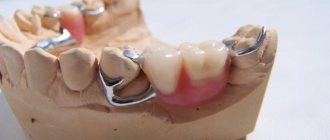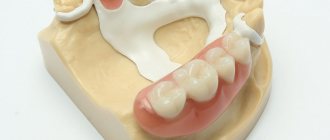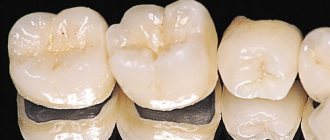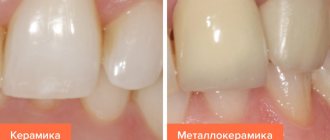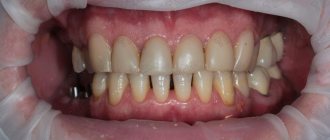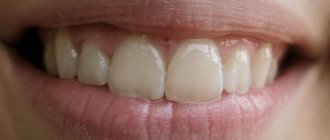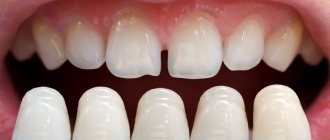Prosthetics with solid-cast bridges are now being used more and more often due to the possibility of eliminating a large number of defects using this method. To understand what this restoration option is, let’s consider how the structure is manufactured in a clinical laboratory setting, and what advantages and disadvantages it has.
What are solid bridges?
Manufacturing of a combined solid-cast bridge prosthesis
A bridge is a structure with supporting elements and several artificial crowns that replace missing teeth. The concept of “solid cast” implies that the structure is cast simultaneously.
The manufacture of a one-piece bridge prosthesis eliminates the adhesion of various elements to each other. The structure is made from casting various alloys, and most often it is gold, silver, palladium, chromium, cobalt.
Simultaneous casting of the prosthesis makes it possible to improve its quality in terms of strength and performance of basic functions. They are now valued in dentistry due to their improved manufacturing techniques and relatively low cost, which allows this restoration option to be considered by a large number of patients.
What they look like
A solid cast bridge resembles a bridge. The design consists of several connected crowns, which allows you to replace a defect on one side of the jaw. Two crowns from the prosthesis are supporting; they are fixed to healthy teeth. Externally, the metal frame has a specific color, which affects aesthetics, which is why this restoration option is being considered for replacing the chewing group of teeth.
Important! The main difference between a solid-cast bridge structure is that it is a single whole without joints or soldered elements.
Such products can be improved by combining different manufacturing options, spraying, and coating with a polymer overlay. This method of restoration is considered for the loss of chewing teeth.
This is what a solid-cast bridge prosthesis of chewing teeth looks like.
Bridges can be placed on the front teeth, but their appearance does not even closely match the natural tissues of the tooth, so more aesthetic options are selected to restore the “smile zone.” If the choice was made on a solid-cast bridge structure, then it is possible to cover it with a composite, which will make the appearance more natural.
Prosthetics with metal-ceramics
Advantages of metal ceramics
The following facts speak in favor of the use of metal ceramics:
- correspondence of artificial metal-ceramic teeth to natural ones in function and appearance
- the possibility of prosthetics for both frontal and lateral teeth, included and end defects of the dentition, the ability to combine removable and non-removable metal-ceramic structures.
- "hygienic" Microbial plaque settles less on metal-ceramic teeth than on natural teeth, which is especially important for patients with periodontitis.
- durability. Today, metal ceramics are one of the most durable structures used in dentistry. If a metal-ceramic crown is made using modern materials and techniques, then its service life is on average from 10 (on a non-precious alloy) to 15 (on a gold-platinum alloy) years.
- A properly made metal-ceramic crown will never cause unpleasant changes in the gums, such as bleeding, changes in color or contour.
Materials used
For the manufacture of solid-cast prostheses, gold (both in pure form and sputtering) and stainless metals, or rather their alloys, are used.
The materials used can be combined, and such a prosthesis will be classified as combined or with veneer. The following materials are used as the base material for the manufacture of a solid-cast bridge:
- gold;
- silver and palladium;
- cobalt and chromium.
Structures made of chromium and cobalt can be improved by manufacturing in their natural form, gold plating, or ceramic coating to resemble natural hard tissues of teeth.
Types
The following types of structures are distinguished:
- Coated with gold prostheses.
Sprayed bridge
- Without spraying - they look like polished metal.
Solid cast bridge without spraying
- With lining - has a composite or plastic lining on the front surface. There is a drawback - the risk of cracks and chips.
Solid cast bridge with veneer
- Combined - the design can be solid in the area of the chewing crowns and ceramic in the smile area to improve aesthetics.
Combined dentures
Preparation for prosthetics
Preparation for the installation of an orthopedic structure can be therapeutic, surgical, orthopedic and orthodontic. Types of preliminary sanitation can be combined, depending on the condition of the oral cavity and the type of defect.
How do you prepare for prosthetics at the dentist:
- Assessment of oral health.
- Carrying out professional cleaning to remove hard dental deposits.
- Carrying out anti-inflammatory therapy if necessary.
- Removal of carious cavities, treatment of pulpitis, periodontitis and other existing pathologies of teeth and mucous membranes.
- Depulpation of teeth (according to indications).
The surgical type of preparation includes the following activities:
- Removal of teeth that cannot be treated. Indications include chronic periodontitis, cysts, and pathological mobility of crowns.
- Removal of soft tissues due to their hypertrophy (hypertrophic gingivitis).
- Complex treatment of dentofacial pathologies.
Orthodontic preparation includes returning the normal bite of healthy teeth through the use of braces, aligners, and plates. Treatment is necessary to correct the position of individual abutment crowns and to create space in the oral cavity for fixation of the bridge structure.
The orthopedic preparation stage includes procedures such as:
- Making corrective aligners to move the advanced crown to the opposite side where the tooth is missing. In this way, the orthopedist creates a place to install the structure.
- Making functional mouthguards to relax the masticatory muscles. Such an event is indicated for hypertonicity in order to prevent breakage of the bridge after installation.
Types of alloys in metal ceramics
Gold-platinum alloy
The classic version with which orthopedic dentistry began. The first crowns were made from gold at the end of the 19th century.
Nowadays, many materials have appeared that, along with solving the problem of restoring chewing function, are quite durable and at the same time meet high aesthetic and cosmetic requirements. But gold, as a material for the manufacture of frames for metal-ceramic prostheses, is still relevant today.
Only a noble alloy can adhere so precisely to the treated tooth, which practically eliminates disintegration and recurrent caries. Gold almost never causes allergies.
The disadvantage of using a gold alloy is the limitation on the length of the intermediate (located between two supports) part of the metal-ceramic bridge (in the manufacture of metal-ceramic bridges), as well as the price: the cost of such a crown is from 10,000 rubles.
Sometimes, to improve color rendition, on a metal frame cast from other metals. a thin layer of gold is applied, which illuminates through a layer of ceramic mass with a warm yellowish color.
Nickel alloy
Most often, nickel-based alloys are used to cast the frame, which is the most accessible of the metals that can be the basis for metal-ceramics. With nickel alloys there are no problems when casting and fitting in the patient's mouth.
However, despite all the advantages, nickel has a serious drawback. This metal is a strong allergen.
Our body's daily need for nickel is thousandths of a gram, and the production of one metal-ceramic crown requires 2 grams of an alloy containing 1.3 grams of nickel. Thus, the metal is in contact around the clock with the oral mucosa, tooth tissues, and jaw. The result is allergic reactions and weakened immunity.
In Germany, they abandoned the use of nickel in dental prosthetics 10 years ago (as well as stainless steel back in the 30s).
Cobalt-chromium alloys
The most optimal option taking into account biocompatibility and cost.
In cost, they are only 1.6 times more expensive than allergenic nickel alloys. The biocompatibility of the cobalt alloy is 36% (for the gold-platinum alloy it is 42%, and only one’s own teeth are 100% biocompatible), they are non-toxic and do not cause allergic reactions. Cobalt alloys are durable, and metal-ceramic bridges of fairly long length can be made from them.
Chromium alloys are not dangerous; only some of its salts are poisonous, but they cannot form in the oral cavity.
Molybdenum
A non-toxic metal, it is added to dental alloys in very small quantities to improve casting properties.
Beryllium
This metal is a carcinogen. It causes granuloma (a type of malignant tumor) in the lungs, liver, spleen and heart. Upon contact with beryllium, skin diseases develop and a severe weakening of the immune system is observed. In Russia, its use in dental alloys is prohibited.
Clinical and laboratory stages of manufacturing a bridge prosthesis
Stages and their features (K - clinical, L - laboratory):
- K - the dentist makes a diagnosis, selects the type of construction together with the patient, prepares the abutment crowns, after which impressions are taken.
- L - creation of a plaster model, selection of the color of the prosthesis, creation of a temporary structure.
- K - fitting the temporary product, checking occlusion.
- L - casting of a permanent bridge structure.
- K - fitting of the prosthesis.
- L - cladding or spraying.
- K - installation of the structure in the oral cavity, assessing the quality of its fit, fixation with special cement.
The prosthetic procedure will require 2 visits to the dentist’s office:
- First. The defect is assessed, the doctor considers the optimal restoration options, and clarifies with the patient which restoration method is preferable. On the first visit, the oral cavity is sanitized and the supporting elements are ground. The dentist takes impressions, sends them to the laboratory and places temporary aligners.
- Second. The dentist places a ready-made solid bridge, finds out how well it fits the patient, and whether there are any defects. When everything is in order, the structure is fixed with composite cement.
Important! When there are inflammatory pathologies of the mucous membrane or other relative contraindications, several visits to a specialist will be required until the problem is eliminated.
If the quality of the finished product does not match, it will require correction. In this case, prosthetics will also be extended over more than two visits.
Stages of denture casting
The process of making dentures by casting is long and labor-intensive - during the work, dental technicians and dentists carry out measures to cast and adjust prosthetic structures for a specific oral cavity. The work consists of several stages.
First of all, to correctly determine the parameters of dentures, impressions of the lower and upper jaws are taken. To obtain two-layer impressions of teeth, impressions are made in two stages: first with base material, and then with corrective material. Taking dental impressions is done in two ways:
- Without additional orthopedic means – used in case of preparation of tooth heads;
- Using orthopedic devices in the form of screws or other components. After this, the two-layer impression is removed with corrective material. Such prints are more accurate.
The process of taking impressions to make dentures takes only a few minutes and is not accompanied by pain, so anesthesia is not required. After this stage is completed, production of the working model begins. This blank is made from an alloy using nickel, gold, cobalt or titanium. Since this stage is quite long and takes from 5 to 30 days, the patient can have a temporary prosthesis made from cheaper materials installed during this time
Before starting modeling, the stamp is varnished to avoid unevenness. To obtain crowns, a set of waxes and a number of medical technical means are used to melt the material and give the prosthesis model the desired shape.
Modeling of the tooth crown begins with obtaining a cap by dipping a modeling stamp into a mass of molten dipping wax, which is maintained by a wax melter in the consistency that allows obtaining the required wall thickness of the cap. The wall thickness of the wax model of the cap used for lining with metal ceramics is very small - less than half a millimeter. This is the optimal thickness for the material to be cast well.
Then, using an electric spatula, the technician adds other waxes: cervical, modeling, milling. A gating system is formed from wax wire of the required diameter. The number and size of elements of the gating system are chosen so as to ensure not only filling of the mold, but also compensation for the decreasing volume of material due to shrinkage processes, otherwise pores and cavities in the casting are possible.
The next step is to make a casting mold from wax. It is important that the material is treated with a liquid that reduces the tension of the wax and fills small cavities. Another significant point is the same temperature of the material for all parts of the denture. The formation of the alloy structure and the quality of the casting of the product depend on this.
The production of a casting mold includes the procedure for obtaining a duplicate of the plaster model. Such a blank is made from a refractory alloy, and its internal contours must correspond to the contours of the model. During this process, the wax is burned off and the mold is heated to high temperatures necessary to melt the metal used. After this, the alloy is melted and cast. To avoid receiving a defective product, it is necessary to prevent overheating of the material. Otherwise, the product will turn out rough due to the destruction of the mold and the penetration of metal into its walls. Such a labor-intensive process requires high professionalism and the presence of certain knowledge and skills from the dental technician.
Once the design blank has been polished and matched to the patient’s dental impressions, decorative plastic or ceramic coverings are installed. However, this stage is optional, it depends on the wishes of the patient. It should be taken into account that ceramics is a more durable and strong material for installation on dental crowns; in addition, it looks very aesthetically pleasing after installing the prosthesis in the oral cavity.
The process of manufacturing a working model of the structure involves sandblasting and fitting in 2 stages:
- On the model;
- In the patient's mouth.
If the prosthesis meets the necessary requirements, then at this stage it can be installed. In other cases, the design is returned to the dental technician for revision.
Installation process
The entire installation process of a solid cast structure includes the following activities:
- Sanitation of the oral cavity.
- Turning of abutment crowns using anesthesia. About 1.5 mm of tissue is removed. The crown is given a special shape for a secure fit of the prosthesis.
- Taking an impression.
- Trying on a temporary prosthesis with its subsequent fixation.
- Trying on a permanent structure and checking the quality of fit.
- Fixation of the permanent structure with cement.
Advantages and disadvantages
| pros | Minuses |
| Homogeneous design, lack of solder, which increases the strength of the product. Unlike other prostheses, solid ones almost never break, because there are no weak joints | Low aesthetics |
| High strength and durability | The cost is higher than a cast prosthesis |
| Tight fit to the tooth, which prevents food particles from getting under the crown, and this prevents secondary caries and destruction of enamel under the prosthesis, and also reduces the likelihood of damage to the structure | Great thermal conductivity |
| High functional efficiency due to precise modeling of support elements and intermediate parts | Risk of discomfort when eating hot food |
| No darkening factor in the structure in the soldering area | Cannot be determined in case of metal allergy |
| Wax can be used to thicken the walls of an orthopedic product. | The need to grind healthy crowns, which over time leads to their destruction due to malnutrition |
| The one-piece design is better tolerated by patients, the risk of prosthetic stomatitis is reduced | High load on abutment teeth can cause them to become loose |
Indications and contraindications
The demand for soldered prostheses is gradually becoming a thing of the past, which is due to the availability of more modern techniques that make it possible to create reliable and aesthetically attractive structures. However, the choice in favor of such products is justified if there are the following indications:
- Diagnosis of small and medium defects of the included type;
- Belonging of supporting elements to one functional category;
- Stability of large abutment teeth.
Factors limiting the installation of permanent bridge structures include:
- Extended edentia, characterized by the absence of three or more elements located sequentially;
- The presence of defects, the boundaries of which are formed by elements belonging to different functional groups;
- Pathological mobility of units located on both sides of the edentulous area;
- Detection of complex malocclusion development, as well as significant destruction of crowns;
- Diagnosed periodontitis, occurring in a complex form;
- Excessive vulnerability of dental tissue, expressed in accelerated abrasion of the enamel coating.
The final choice of a prosthetic system is based on the results obtained during a preliminary clinical examination of the dentition.
Contraindications
One-piece denture in the mouth
There are relative and absolute restrictions that do not allow the installation of a solid-cast bridge. The first include conditions that this method of recovery completely excludes. Relative contraindications are considered individually.
A solid-cast bridge is not used in the following conditions:
- defects when more than 1 molar, 2 premolars and 4 incisors are missing;
- infectious and inflammatory pathologies of the jaw bones, including osteomyelitis and osteoporosis;
- psychological illnesses that do not allow the patient to take care of himself, as well as epilepsy;
- oncological diseases;
- pathologies accompanied by blood clotting disorders;
- allergy to the materials used or anesthetic substance.
Relative restrictions to this recovery option will be:
- teeth grinding at night or bruxism;
- acute period of inflammatory pathologies of the oral mucosa;
- poor oral hygiene;
- pathological abrasion of enamel;
- severe pathologies of periodontal tissues with frequent relapses;
- abnormal dental bite that cannot be corrected.
Advantages of cast dentures
Cast dentures can be single or bridge-like, covering several teeth. Depending on which part of the dentition needs to be replaced, there are crowns used to completely replace a tooth, structures that restore a damaged tooth in the presence of a stump, crowns that restore the height of a tooth, and half-crowns necessary to support dentures in the mouth. In order to determine what type of prosthetic dental structure is needed in a particular case, a detailed consultation with a dentist is required.
Metal cast dentures have been used in dentistry for many decades; over the years they have been repeatedly improved, maintaining and increasing their positive qualities. Using this technique, permanent prosthetic structures for teeth are made.
Among the main advantages of dentures made by casting are the following:
- The method of manufacturing such dental prostheses ensures their tight fit without damaging the oral mucosa. This not only increases the aesthetics and comfort when using dentures, but also reduces the likelihood of oral diseases.
- Thanks to the materials and manufacturing methods used, prosthetic structures made by casting are characterized by a long service life. Dentures require replacement or adjustment no more than once every 10 years.
- The materials from which such dentures are made prevent the accumulation of pathogenic microbes in the mouth.
- Safety for teeth is ensured by the strength of the materials from which such dentures are made. They allow you to avoid grinding and deformation of teeth, which is important when installing cast bridges, which cover healthy teeth on both sides of the missing teeth to be replaced.
- The affordable cost of such dental prostheses is an important factor for many clients of dental clinics, since among them there are often pensioners and other socially vulnerable segments of the population.
- Precision in the manufacture of dentures is ensured by casting technology. Due to the fact that the cast dental prosthesis is made in one piece and does not require soldering of small parts, it fits tightly in the mouth and occupies the space in the mouth that was intended for natural teeth.
- Comfort when wearing and the patient’s quick adaptation to a new denture is one of the main advantages from the point of view of those who will wear it.
These distinctive features of cast oral dentures make them popular and widely used in prosthetic dentistry.
Service life and care
With proper care, a solid-cast bridge can last for 15 years without breaking. The service life of such a product is practically unlimited, but it is important to visit a doctor regularly in order to identify problems in time and solve them at the initial stage.
What you need to do to properly care for a solid bridge:
- regularly clean your mouth in compliance with standard hygiene rules;
- use a toothbrush, dental floss and a special brush daily to clean the spaces between the gum and the structure;
- use an oral irrigator several times a week;
- visit the dentist every few months for professional oral hygiene and assessment of the condition of the orthopedic structure;
- rinse and clean the mouth after each meal, for which it is enough to use a deodorizing mouthwash or a solution prepared at home from herbs, which will prevent inflammatory diseases.
Important! Installation of a one-piece denture makes it impossible to carry out standard professional oral hygiene. The dentist uses special cleaning products and brushes to clean your teeth. It is also unacceptable to use the irrigator in high pressure mode, directing the stream at the prosthesis.
Materials for casting dentures
The dentist and technician must know the properties of the materials that are used to make prosthetic structures in order to give the necessary recommendations to patients. In this matter, it is necessary that the dentist be in close communication with dental technicians, and they can combine knowledge and skills to select the most successful material for the manufacture of the prosthesis.
The part of the dentition on which the prosthesis will be installed is important in the choice of material. In addition, it is taken into account what kind of denture is being made: a bridge-like structure that replaces several teeth, a crown for one tooth, or a clasp to fix the structure. The load that the denture will experience during use in the oral cavity depends on this, since it should not be deformed or wrinkled when chewing.
An important characteristic is the elasticity of the material, which must be optimally combined with its strength. This is especially important for the materials from which small structures for dental prosthetics are made: clasps and inlays. They must remain flexible enough to withstand use in the mouth.
The ease of melting and casting of the material is important for technicians making these types of dentures. The fewer conditions required for high-quality casting of a structure, the better. In addition, attention is paid to such a characteristic as the shrinkage of the material after melting. Often, due to excessive shrinkage of the material during the casting of dentures, defects are obtained. Therefore, it is important for specialists to know the properties of the materials they work with. This applies not only to metals and alloys, but also to waxes used to prepare a model of a structure for prosthetics.
Dental technicians work with both precious metals (gold, platinum) and non-precious metals and alloys (titanium and cobalt-chromium). As a rule, the service life of dentures made from noble materials is 5-6 years longer than that of simpler analogues. However, all these materials meet the requirements of density, strength and ease of melting and casting.
Price
The approximate cost of a solid-cast bridge varies from 7,000 rubles. The price differs depending on the length of the defect and the metal alloys used.
The cost will be higher if the structure is additionally coated with ceramics to improve the appearance. Also, the price differs for combined dentures and products with veneering.
To choose a prosthetic method, consult an orthopedic dentist. The doctor will conduct the necessary research, select which prosthesis is best suited in a particular situation, and tell you about all the intricacies of subsequent prosthetics.


